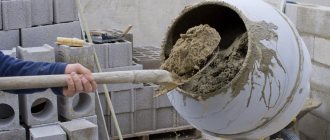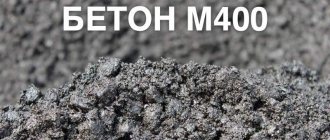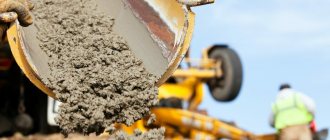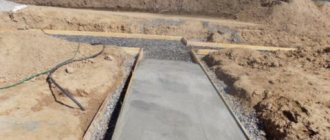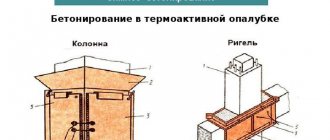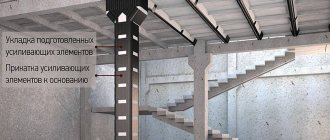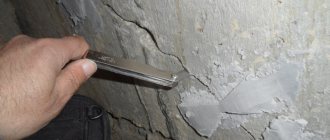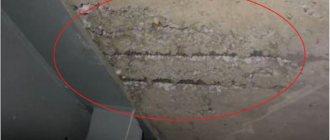Ultrasonic testing of concrete strength is a non-destructive method for determining the strength characteristics of a material, which is based on the dependence of an indirect characteristic (device readings) on the strength of concrete. An indirect indicator is the time and speed of propagation of ultrasound or other indications that are obtained when measuring strength characteristics. An indirect indicator is linked to the strength of the material by a calibration dependence (analytical or graphical).
According to GOST 17624, inspection of monolithic structures using ultrasonic testing is carried out using the through-sounding method. Also, the experience of the laboratory of the State Unitary Enterprise NIIZHB has shown that for monolithic structures it is possible to use the ultrasonic testing method by surface sounding. The sounding base is the distance between the centers of the emitter and receiver, i.e. ultrasonic transducers, which are installed during surface sounding on the same surface, or between the centers of ultrasonic transducers during through sounding.
Features of ultrasonic testing
Ultrasonic testing is used to determine the strength of concrete at intermediate and design (usually 28 days) age, as well as at an age that exceeds the design age when examining structures. The age is established by the design documentation. When ultrasonic testing the strength of concrete, through or surface sounding is used. In this case, superficial sounding is more often used. The end-to-end method is used if it is possible to measure the base with a relative error of no more than 0.5%.
Strength characteristics are determined by calibration dependencies established experimentally in areas of structures that do not have visible damage, for example, cracks, cavities, or peeling of the protective layer. The temperature of the material should not be lower than -5 degrees.
Pull-out testing on concrete for non-destructive testing of concrete
The pull-out test measures, using a special plunger, the force required to pull out of concrete a specially shaped steel rod whose extended end has been embedded into the concrete to a depth of 7.6 cm.
Concrete is tested simultaneously for tension and shear, but the force required to pull the concrete can be related to its compressive strength.
Thus, the pullout method can quantitatively measure the strength of concrete in situ when appropriate correlations have been made. Over a wide range of values, tensile strength was found to have a coefficient of variation comparable to that of compressive strength. In other words, they are almost equal.
Limitations and advantages of pull-out testing
Although pull-out or pull-out tests do not measure the internal strength of mass concrete, they do provide information about the maturity and strength development of a representative portion of it. Such tests have the advantage of quantitatively measuring the strength of concrete in situ.
Their main disadvantage is that they must be planned in advance and the subassemblies must be installed in the formwork before the concrete is placed. The extension, of course, creates some structural damage.
The test can be non-destructive, however, if a minimum pullout force is applied that does not destroy the formwork and ensures that the minimum force has been achieved. This information is of particular value in cases where the test fails and the entire batch of concrete is rejected.
Types of ultrasonic equipment for concrete flaw detection
Concrete testing is carried out with instruments that measure the time and speed of propagation of ultrasound. The equipment must be certified and tested in accordance with the established procedure. The error in measuring the propagation time of ultrasound on standard samples included in the device package should not exceed +/-0.01t+0.1 (t is the propagation time of ultrasonic radiation, μs).
If the determination of concrete strength by ultrasonic testing is carried out using several instruments at one site, the readings before constructing the calibration dependence are calibrated on one standard so that they do not exceed 0.5%. The size of the base when sounding superficially should be 120-200 mm. Reliable acoustic contact is ensured between the surface of the material and the working surfaces of ultrasonic devices. At the same time, the method of ensuring contact does not differ both when testing concrete and when constructing a calibration relationship. It is unacceptable to use ultrasonic devices calibrated in concrete strength units to determine its characteristics. An indirect indicator is used only after the calibration dependence installed in the device has been established or clarified in accordance with GOST requirements.
Ultrasonic method for studying concrete
Currently, the ultrasonic pulse velocity method is the only method of its type that shows potential for in situ testing of concrete strength. It measures the transit time of an ultrasonic pulse passing through concrete.
The basic design features of all commercially available devices are very similar, they consist of a pulse generator and a pulse receiver.
The pulses are generated by shock-exciting piezoelectric crystals with similar crystals used in the receiver. The time it takes for the pulse to pass through the concrete is measured by electronic measuring circuits.
ultrasonic method
Pulse velocity tests can be performed on both laboratory samples and finished concrete structures, but several factors affect the measurement:
- There must be even contact with the surface being tested; Mandatory medium such as a thin layer of oil.
- It is advisable that the path length be at least 30 cm to avoid any errors caused by inhomogeneity.
- It should be recognized that at temperatures below zero there is an increase in the pulse frequency due to the freezing of water; – from 5 to 30 °C pulse speeds are independent of temperature.
- The presence of reinforcing steel in concrete significantly affects the impulse speed. It is therefore desirable and often mandatory to select impulse paths that eliminate the influence of reinforcing steel, or to make adjustments if steel is in the impulse path.
Applications and limitations of ultrasound in concrete
The pulse velocity measurement method (ultrasonic method) is an ideal tool for determining the uniformity of concrete. It can be used on both existing and new structures.
Typically, if large differences in impulse velocity are found within a structure for no apparent reason, there is good reason to believe that there is defective or damaged concrete.
High impulse velocity readings generally indicate good quality concrete. The general relationship between concrete quality and impulse speed is given in Table.
Preparatory activities
Preparation for testing is carried out in stages and includes checking the devices in accordance with their operating instructions, as well as obtaining information for constructing calibration dependencies.
The construction of calibration dependencies for surface sounding is carried out based on the results:
- parallel testing of identical sections of structures using the ultrasonic method and the tear-off method with chipping (GOST 22690);
- ultrasonic testing and mechanical testing of cores that were selected from the same sections of structures and tested in accordance with GOST 28570;
- ultrasonic testing and mechanical testing of identical standard concrete samples (GOST 10180).
For end-to-end sounding, the calibration dependence is constructed based on the following results:
- testing sections of structures using the ultrasonic method and researching in accordance with GOST 28570 core samples that were selected from the same sections;
- ultrasonic testing and mechanical testing of identical standard concrete samples (GOST 10180).
The construction of calibration dependencies is carried out separately for each type of standardized strength for concrete with one nominal composition. It is permissible to build one dependence for a material of one type, if it differs in the value of standardized strength and nominal composition, but not more than 3 standardized classes.
The age of concrete in individual areas cannot differ by more than 25% from the average age of the material in the structure zone or group of structures where the tests are being carried out. Age in individual areas is not taken into account if the calibration dependence is established for structures built no more than 2 months ago. The position of the reinforcement is first determined in the areas under study.
Methods of instrumental examination of building structures
The purpose of instrumental inspection of buildings is to obtain quantitative data on the condition of load-bearing and enclosing structures: deformation, strength, cracking and humidity.
Instrumental inspection is subject to structures with obvious defects and damage detected during visual inspection, or structures determined selectively according to the condition: at least 10% and at least three pieces in a temperature block. The methods of instrumental examination and the equipment used for this are given in the table below.
| No. | Parameter under study | Test or measurement method | Tools, devices and equipment used in instrumental examination |
| 1 | Volumetric deformation of the building | Leveling, theodolite survey | Levels N-3, N-10, NA-3, etc. Theodolites T-2, T-15, TaN, etc. |
| 2 | Deflections and movements | Leveling. Deflection meters of mechanical action and liquid ones based on the principle of communicating vessels | Levels: N-3, N-10, NA-1, etc. Mechanical deflection meters PM-2, PM-3, PAO-5. Liquid deflection meters P-1 |
| 3 | Strength of concrete | Plastic deformation method (GOST 22690.0-88). Ultrasonic method (GOST 17624-87). Tear-off method with chipping (GOST 226900-88). Squeezing method | Fizdel hammer, Kashkarov hammer, springy devices: KM, PM, KhPS, etc. UKB-2, Beton-5, UK-14P, Beton-12, etc. GPNV-5, GPNS-4. Torque clamps |
| 4 | Mortar strength | Plastic deformation method | Sclerometer SD-2 |
| 5 | Hidden defects in the construction material | Ultrasonic method. Radiometric method | Ultrasonic devices: UKB-1, UKB-2, Beton-12, Beton-5, UK-14P. Radiometric devices: RPP-1, RPP-2, RP6S |
| 6 | Depth of cracks in concrete and masonry | Ultrasonic method. Radiometric method | Hammer, chisel, ruler. UK-10PM, Beton-12, UK-14P, Beton-5, Beton-8URTs, etc. |
| 7 | Crack opening width | Measurement with steel probes, etc. Using a reading microscope | Feeler gauge, ruler, caliper, MIR-2 |
| 8 | Thickness of the protective layer of concrete | Magnetometric method | IZS-2, MI-1, ISM |
| 9 | Density of concrete, stone and bulk materials | Radiometric method (GOST 17623-87) | Radiation sources Cs-137, C0-60. Remote element type IP-3. Counting devices (radiometers): B-3, B-4, Beton-8-URTs |
| 10 | Humidity of concrete and stone | Neutron method | Ra-Be radiation source, NV-3 sensor. Counting devices: SCh-3, SCh-4, “Bamboo” |
| 11 | Breathability | Pneumatic method | DSK-3-1, IVS-2M |
| 12 | Thermal protection qualities of wall fencing | Electrical method | Temperature probes: TM, TsLEM. Thermometer LTIHP |
| 13 | Sound conductivity of walls and ceilings | Acoustic method | White noise generator GShN-1. Amplifiers: UM-50, U-50. Sound level meter Ш-60В. Spectrometer 2112 |
| 14 | Structure vibration parameters | Visual method. Mechanical method. Electro-optical method | Vibromark, Geiger vibrograph, manual vibrograph VR-1. Oscilloscopes: N-105, N-700, OT-24-51, set of vibration sensors |
| 15 | Foundation settlement | Leveling | Levels: N-3, N-10, NA-1, etc. |
During instrumental inspection of buildings, special attention is paid to the strength of structural materials. The strength of concrete is determined both by non-destructive methods (ultrasound, plastic deformation) and by partial destruction of the structure body (separation with chipping, extraction of cores for laboratory tests, etc.).
It should be emphasized that the most reliable information about the strength of concrete is provided by core testing. It is this method that is recommended to be used for instrumental examination of critical structures. Strength indicators of reinforcement are established by testing samples cut from structures most damaged by fire. If there are no experimental data, then the amount of reduction in the strength of concrete and reinforcement is determined through reduction factors regulated by the standards for technical inspection of the building.
How is strength control carried out?
Ultrasonic testing of concrete is a complex process. Tests are carried out in accordance with GOST 17624. According to the standard, the number and location of sections examined in the structure must comply with the requirements of GOST 18105 and be indicated in design documents or established taking into account:
- type of structure: beams, columns, slabs, etc.;
- control tasks: establishing the actual class of concrete, tempering or stripping strength, identifying zones of reduced strength, etc.;
- the order of concreting and placement of grips;
- structural reinforcement.
Strength characteristics are determined in each section using surface or through sounding methods. In monolithic or prefabricated structures, where the use of through sounding is difficult, surface sounding is carried out. These are ribbed, flat or hollow-core floor panels, pipes, wall panels, etc.
When sounding superficially, the base should be similar to that which was used when constructing the calibration dependence. In this case, the age of the concrete of the structure under study cannot differ from the age of the sample material that was tested to construct the calibration dependence by more than 50% when establishing the standardized strength and by more than 25% when determining the characteristics during the hardening process of the material.
When sounding through, measurements are carried out in a direction that is perpendicular to the direction of the working reinforcement. To exclude the influence of reinforcement on the results obtained from surface sounding, studies are carried out according to a special scheme. Moreover, with surface sounding, each section is measured at least 2 times, and with through sounding - 1 time.
Ultrasonic device for monitoring the strength of concrete UKS-MG4
The UKS-MG4 device is designed for monitoring defects, determining the strength of concrete using the ultrasonic method in prefabricated and monolithic concrete and reinforced concrete products and structures in accordance with GOST 17624, determining the strength of sand-lime brick in accordance with GOST 24332 and other solid materials based on measuring the propagation time of pulsed ultrasonic oscillations (UT) on the installed sound base. Equipped with a device for automatically determining the pressing force of the probe with setting the parameters of ultrasonic testing pulses, and display backlighting.
When working with the UKS-MG4 device, the surface sounding method is used.
Main functions of the devices:
- Measuring the time and speed of propagation of ultrasound in materials during through and surface sounding
- Determination of the strength of building materials using the established calibration relationship
- Assessment of the strength of concrete of unknown composition using the calibration characteristics of TsNIIOMPT
- Possibility of installing individual graduations for various types of building materials
- Determination of crack depth
- Search for defects based on an abnormal decrease in the speed of ultrasound propagation
- Archiving of information obtained as a result of measurements in the device’s memory, recording the time, date, type, characteristics of the building material and the coefficient of variation (memory capacity 10,000 results).
- Transfer of information obtained as a result of measurements to a PC
The electronic unit of the device is combined with transducers for surface sounding (base 120mm), which ensures ease of use, small dimensions and weight.
The scope of application of the devices is buildings and structures under construction and operation, hydraulic structures, structures with difficult two-way access to controlled areas, construction industry enterprises.
Note: In accordance with GOST 18105, the ultrasonic method is classified as an indirect method for determining the strength of concrete. In this connection, the determination of the strength of concrete is carried out according to pre-established calibration relationships between the strength of concrete, established by one of the destructive or direct non-destructive methods, and the indirect characteristics of the device.
CONTENTS OF DELIVERY
An electronic unit combined with a probe for surface sounding, a control sample, a packaging case, a communication cable with a PC, a CD with software, an instruction manual.
Warranty period is 18 months. Service and metrological maintenance is provided throughout the entire service life.
Other popular devices: ultrasonic thickness gauge, dynamometer.
Protocol for ultrasonic testing of concrete
The test report is drawn up within the framework of the GOST 17624 appendix. The area where the ultrasonic research was carried out is indicated here, as well as the strength of the material in this area. Next, the average strength of concrete by design is recorded, and based on the results obtained, the material is assigned a class. The test results are presented in table form. It indicates the type of structure, design class of the material, age, strength of concrete in each controlled area and the actual strength class calculated in accordance with GOST 18105. The format of the table of research results can be viewed in Appendix G GOST 17624.
Concrete Penetration Method
The probe is generally considered the best tool for testing the strength of concrete using the penetration method. The equipment consists of a gun driven by gunpowder, a series of hardened alloy sensors, loaded cartridges, a depth gauge to measure probe penetration and other associated equipment.
The 6.5 mm diameter and 8.0 cm long probe is driven into the concrete using a precise powder charge. The penetration depth provides an indicator of the compressive strength of concrete.
Each probe has calibration tables provided by the manufacturer and must be calibrated for the type of concrete and the type and size of aggregate used.
Limitations and Benefits
Probe testing produces highly variable results and should not be expected to provide accurate concrete strength values. However, it has the potential to provide a rapid means of in-situ testing of concrete quality and maturity.
This also makes it possible to evaluate the development of force during concrete curing. The test is essentially non-destructive as concrete and structural members can be tested in situ, the test results in minor patches of holes on exposed surfaces.

